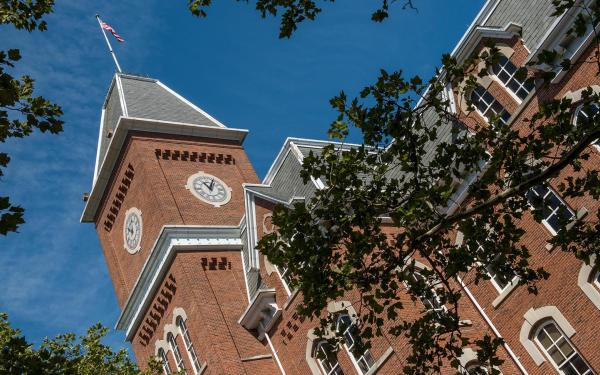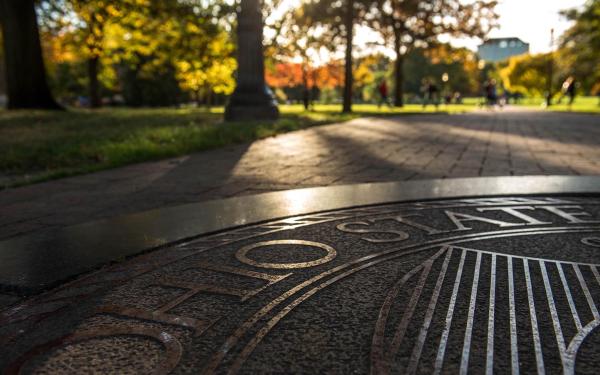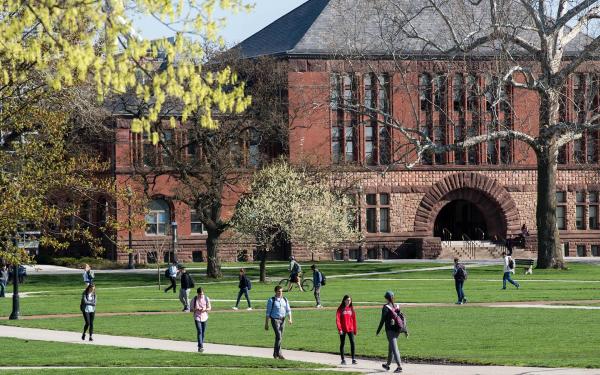Congratulations on your admission to The Ohio State University!
We invite you to join us for our annual Experience Arts and Sciences Day. This exclusive event provides admitted students and their families an enhanced preview of just how much the College of Arts and Sciences at Ohio State has to offer.
Saturday, February 15, 2025
9:45 a.m. to 5 p.m.
Ohio State's Columbus campus
Please register by February 10.
9:45-10:45 a.m.
Registration, check-in and academic fair
Physics Research Building Atrium
191 W. Woodruff Ave.
10:45-11 a.m.
Travel to Independence Hall
1923 Neil Ave.
11-11:15 a.m.
Welcome by David Horn, Dean, College of Arts and Sciences
100 Independence Hall
1923 Neil Ave.
11:15-12 p.m.
Admitted Student post-acceptance processes
100 Independence Hall
1923 Neil Ave.
12-12:30 p.m.
Travel to next session
12:30-1:15 p.m.
Sample class 1 (Select one to attend as part of the registration process. View class descriptions below.)
- Line, Shadow and Silhouette: History and Practice
by George Rush
Hayes Hall, Room 330
108 N. Oval Mall
- Explore the world of languages
by Janice Aski and other world language faculty
Hagerty Hall, Room 180
1775 College Rd. S
- Searching for the Giant Ground Sloth Megalonyx and a tour of historic Orton Hall
by Loren Babcock
Orton Geological Museum, Orton Hall Room 110
155 S. Oval Mall
- Is GATTACA on the Way? Using the CRISPR/Cas 9 Bacterial Defense System to Edit the Genome
by Susan Cole
Stillman Hall, Room 100
1947 College Rd.
- Equality in the 21st Century
by Piers Turner and Sahar Heydari Fard
Journalism Building, Room 270
242 W. 18th Ave.
- When did we become human?
by Mark Hubbe
Journalism Building, Room 371
242 W. 18th Ave.
- Thinking about the Good Life
by Steven Brown
Journalism Building, Room 239
242 W. 18th Ave.
- HIV: From Microbiology to Macro History
by Jesse Kwiek and Thomas McDow
Psychology Building, Room 10
1835 Neil Ave.
- Mapping a World of Possibilities
by Larisa Kruger
Denney Hall, Room 238
164 Annie and John Glenn Ave.
- Learn more about the Universe with the Department of Astronomy at the Arne Slettebak Planetarium
by Wayne Schlingman
Smith Laboratory
174 W. 19th Ave.
1:15-2:30 p.m.
Lunch on your own
University dining locations
2:30-3:15 p.m.
Sample class 2 (Select one to attend as part of the registration process. View class descriptions below.)
- Line, Shadow and Silhouette: History and Practice
by George Rush
Hayes Hall, Room 330
108 N. Oval Mall
- Explore the world of languages
by Janice Aski and other world language faculty
Hagerty Hall, Room 180
1775 College Rd. S
- Searching for the Giant Ground Sloth Megalonyx and a tour of historic Orton Hall
by Loren Babcock
Orton Geological Museum, Orton Hall Room 110
155 S. Oval Mall
- Is GATTACA on the Way? Using the CRISPR/Cas 9 Bacterial Defense System to Edit the Genome
by Susan Cole
Stillman Hall, Room 100
1947 College Rd.
- Equality in the 21st Century
by Piers Turner and Sahar Heydari Fard
Journalism Building, Room 270
242 W. 18th Ave.
- When did we become human?
by Mark Hubbe
Journalism Building, Room 371
242 W. 18th Ave.
- Thinking about the Good Life
by Steven Brown
Journalism Building, Room 239
242 W. 18th Ave.
- HIV: From Microbiology to Macro History
by Jesse Kwiek and Thomas McDow
Psychology Building, Room 10
1835 Neil Ave.
- Mapping a World of Possibilities
by Larisa Kruger
Denney Hall, Room 238
164 Annie and John Glenn Ave.
- Learn more about the Universe with the Department of Astronomy at the Arne Slettebak Planetarium
by Wayne Schlingman
Smith Laboratory
174 W. 19th Ave.
3:15-3:30 p.m.
Travel to 100 Independence Hall for optional campus tour
1923 Neil Ave.
3:30-5 p.m.
Optional Campus Tour
Departs from 100 Independence Hall
1923 Neil Ave.
Line, Shadow and Silhouette: History and Practice
by George Rush (Hayes Hall 330)
Join us as we look at how artists have used line and shape to capture the human figure, from ancient Greece to the present. Students will then have an opportunity to take some of what we’ve learned and put it into practice, creating silhouette portrait drawings of themselves and each other. This session introduces students to the way college-level art courses combine historical precedents with hands on experience in order to make connections between the past, present, theory and practice.
Explore the world of languages
by Janice Aski and other world language faculty (Hagerty Hall Room 180)
The process of learning a new language provides many intercultural skills that are transferable to working with people from backgrounds different from your own. Hear it from Ohio State students.
In fact, Intercultural Competence is rated among the top skills needed for working in the future. This session will begin with a short introduction by the director of the Center for Languages, Literatures, and Cultures, who will briefly discuss Ohio State languages and the programs and scholarships available for study and internships abroad. You will then participate in a surprise language lesson and find out for yourself how learning a new language contributes to your future life and career.
Searching for the Giant Ground Sloth Megalonyx and a tour of historic Orton Hall
by Loren Babcock (Orton Geological Museum, Orton Hall, Room 110)
The Orton Geological Museum’s renowned collection of fossils, minerals, rocks, building stones, and meteorites includes specimens dating to the early years of exploration in North America. The museum is home to the oldest mounted skeleton of a fossil animal in America, the giant ground sloth Megalonyx. Exploring Orton Hall provides an opportunity to glimpse at Ohio State’s early history, learn about some of the university’s cherished treasures, and experience the excitement of a modern scientific investigation on the fossils of a fascinating Ice Age mammal.
Is GATTACA on the Way? Using the CRISPR/Cas 9 Bacterial Defense System to Edit the Genome
by Susan Cole (Stillman Hall Room 100)
The last five years have seen an explosion of interest in a simple bacterial defense system called CRISPR. Some bacteria use this system to protect themselves from invading viruses. Scientists have harnessed CRISPR to edit the DNA of research animals and possibly ourselves. This procedure could someday allow scientists to make changes to the human genome with pinpoint precision. What implications does this have for research? For medicine? For human evolution and society? We will discuss how CRISPR works, what scientists currently use it for, and what changes could be on the way soon.
Freedom in the 21st Century
by Piers Turner and Sahar Heydari Fard (Journalism Building, Room 270)
Almost everyone is committed to equality in one form or another — moral, social, political, or economic. But there is significant disagreement about what kinds of equality matter and what intervention might be justified to achieve them. We will discuss some leading theories of equality — luck egalitarianism, sufficiency views, and relational equality — as a way of exploring the nature and limits of our egalitarian commitments.
When did we become human?
by Mark Hubbe (Journalism Building, Room 371)
Around 8 million years ago, our ancestors separated from the ancestors of all modern Chimpanzees and Bonobos. Over this time period, we evolved to become a remarkable life form on the planet, capable of using our cultures, ideas, and technologies to overcome many of the limitations imposed by our own bodies. Humans are one of the most widespread species on the planet, occupying every corner of the planet. And no other species has had such an impact on the planet in such a short time as we did. However, when, in the course of these 8 million years of evolution, did we become human? How far back can we travel back in time and still recognize our ancestors as part of humanity? Join me in this lecture and we will explore the main steps of our evolution, look at many of our ancestors, including replicas of their fossils, and try to answer this question.
Thinking about the Good Life
by Steven Brown (Journalism Building, Room 239)
Is happiness a state of mind, or something more? Can we be mistaken about our happiness? Participants in this sample class will engage in philosophical reflection and discussion in order to clarify what really matters in their lives.
HIV: From Microbiology to Macro History
by Jesse Kwiek and Thomas McDow (Psychology Building, Room 10)
This course is an interdisciplinary exploration of HIV/AIDS. An estimated 39 million people around the world were living with HIV, a number startling close to the estimated number of people who have died from AIDS since 1981. Unlocking the virological secrets of HIV/AIDS has been one of the grand scientific challenges of the last three decades, and the disease remains one of the world’s most serious challenges to human health and development. The burden of the disease is uneven globally, and sub-Saharan Africa, where the disease originated, is home to 69% of those living with HIV today. How did this virus and this global pandemic come to be? The course considers the origin of the virus and traces its evolution at both the molecular level and within in its global historical context. Team-taught by a virologist (Kwiek) and a historian (McDow), the goal of the class is to put the sciences and humanities in conversation.
Mapping a World of Possibilities
by Larisa Kruger (Denney Hall, Room 238)
The science of Where (Geographic Information Systems) is being integrated into almost every aspect of our lives. Join us for a sampling of How. From routing around traffic issues, providing spatial analytics for retail and marketing giants, locating 911 callers down to their location within a building, or collecting imagery or Lidar with our drones, GIS is improving decision making, providing cost savings and helping us create a more sustainable world. We’ll share how we are implementing these technologies and solutions at Ohio State through our field collection maps, ArcGIS Online applications and drone demo.
Learn more about the Universe with the Department of Astronomy at the Arne Slettebak Planetarium
by Wayne Schlingman (Smith Laboratory)
Hear about how astronomers explore the universe and be amazed at how small the Earth is compared to the entirety of space.



